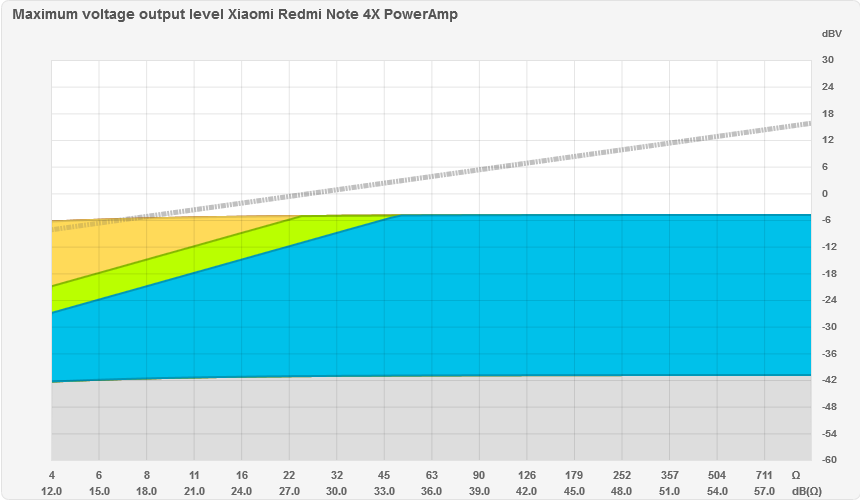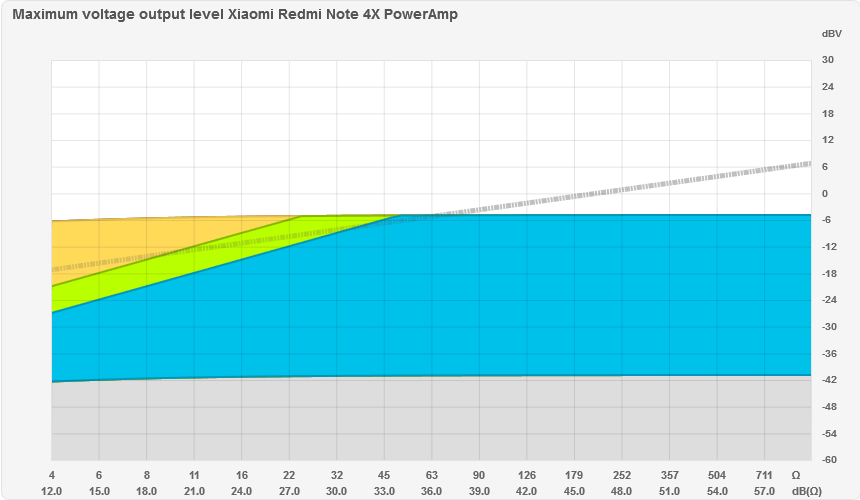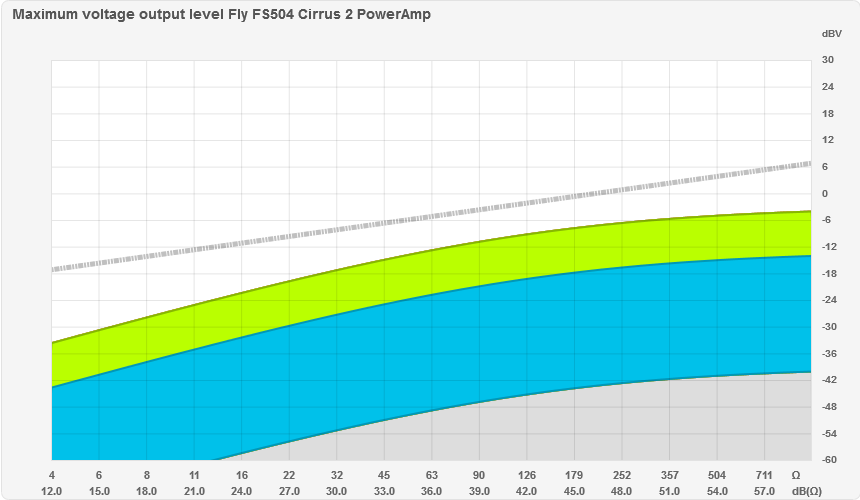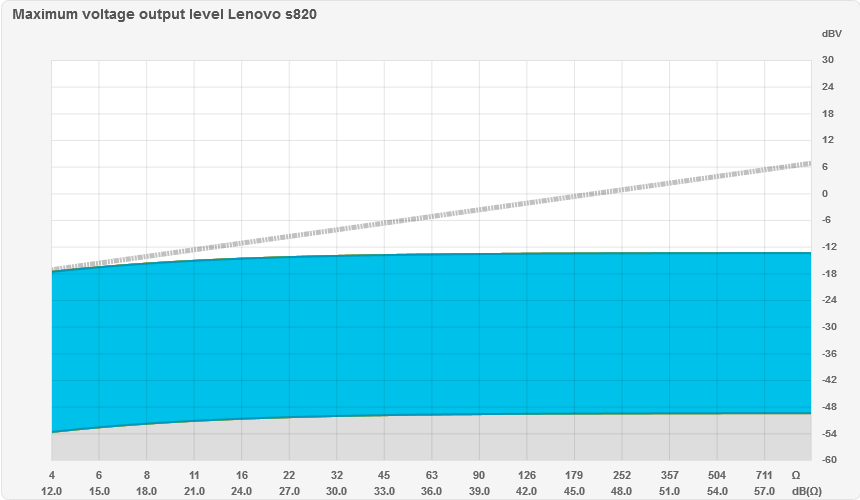For amplifiers, you can often see such a characteristic as “recommended headphone impedance” in the form of a resistance range.

Manufacturers usually define this characteristic subjectively by trying their amplifier with different models of headphones. Others are guided by the characteristics of competitors and adapt to them, if the other characteristics are similar. With this approach, products inevitably appear, for some of which this characteristic becomes overestimated, and for others it is underestimated. There is no single formula for this characteristic.
But, as is often the case, if many manufacturers indicate a similar characteristic (similar to the “frequency range” for headphones), then there is a false impression that there is some kind of standard for this.
This characteristic can be derived and calculated by approaching such a task from the original meaning of the characteristic and summarizing the data from the manufacturers. If the manufacturers take this data subjectively, then they can be considered empirical and made a certain point of reference. Understanding the calculation algorithm, one can always make the necessary correction.
Characterization
The main essence of the characteristics is to determine with which headphones the amplifier will be able to produce an acceptable volume level and at the same time will work qualitatively (have a good sound).
We know that the main limitation for high-impedance headphones is voltage, and for low-impedance ones - current. Since the main difference is mainly indicated for the high-impedance headphone boundary, we need to determine which sound pressure level from the point of view of most manufacturers is acceptable for high-impedance models.
In the sample based on the RAA, there were products that manufacturers recommend for headphones with an impedance of up to 600 Ohms.
Model / Maximum Voltage Level:
ASUS Essence One MK2 16.2 dBV
ASUS Essence 3 Balanced 16.5 dBV
ASUS Essence 3 Unbalance 15.7 dBV
ASUS Xonar Essence STX Hi 16.3 dBV
ASUS STRIX RAID DLX Hi 15.4 dBV
ASUS STRIX RAID PRO Hi 15.4 dBV
ASUS ROG Xonar Phoebus 15.4 dBV
Cary Audio HH-1 18.9 dBV
Creative Sound Blaster X7 LE 15.7 dBV
Creative Sound BlasterX AE-5 14.5 dBV
Creative Sound Blaster E5 14.8 dBV
Erzetich Perfidus 17.0 dBV
Erzetich Bacillus Tilia 18.1 dBV
Musatoff HA-4 14.8 dBV
MyST DAC 1866OCU V.2 17.6 dBV
OPPO HA-1 16.7 dBV
OPPO HA-1 Balance 24.5 dBV
The link is the same list for the sample in the RAA measurement database, but with additional models, since Filtering is done by brand.The list shows that the minimum voltage for 600 Ohms is 14.5 dBV (voltage is already expressed in decibels).
In headphones, the sensitivity parameter is expressed both in voltage and in power. The first option allows us to conclude about the “volume” of the headphones without considering their resistance, which is very convenient when we compare headphones with different resistances. The second option shows their efficiency. In this case, if you make the same headphones, but with different resistance of the inductor, their efficiency will be the same (the same sensitivity to power), but the sensitivity to voltage will differ depending on their ratios of their resistances as 10 * Log10 (R1 / R2).
When calculating the ratios of voltages in decibels, the formula 20 * Log10 (V1 / V2) is used, with the difference in sensitivity to power 10 * Log10 (R1 / R2).The 16 ohm / 600 ohm impedance ratio is -15.7 dB and headphones with 600 ohm impedance will be 15.7 dB quieter than 16 ohm headphones with a different design.
Thus, we need to determine the average level of sensitivity to power among high-impedance headphones, sifting out headphones with a non-standard design.
Since Since sampling is necessary primarily for the design of headphones for high-impedance models, and not strictly for high-impedance models, this allows sampling on a wide range of models in a larger resistance range and obtaining a more adequate average value for sensitivity.
Under the link the same list, but with additional models of a non-standard design or with active strengthening. Below are data on headphones with a resistance of 150 ohms.AKG K 340 ED 91.7 dB / mW SPL 398.6 Ohm
Beyerdynamic DT 770 Pro 250 Ohm 94.5 dB / mW SPL 254.4 Ohms
Beyerdynamic DT 880 Pro 95.6 dB / mW SPL 252.9 Ohm
Beyerdynamic DT 990 Pro 250 Ohm 93.4 dB / mW SPL 267.4 Ohms
Beyerdynamic DT 150 250 ohm 99.3 dB / mW SPL 280.1 Ohm
Beyerdynamic DT 250 250 ohm 101 dB / mW SPL 268.7 Ohm
Beyerdynamic DT 48 E 200 ohm 99.2 dB / mW SPL 200.1 Ohm
Beyerdynamic DT 660 mk 2 85.6 dB / mW SPL 568.6 Ohm
Beyerdynamic DT 770 600 ohm 96.6 dB / mW SPL 570.8 Ohm
Beyerdynamic DT 797 99.5 dB / mW SPL 259.4 Ohm
Beyerdynamic DT 831 106.2 dB / mW SPL 348.2 Ohm
Beyerdynamic DT 911 106.5 dB / mW SPL 298.6 Ohm
Beyerdynamic DT 931 107.3 dB / mW SPL 328.2 Ohm
Beyerdynamic DT 990 600 ohm 95.4 dB / mW SPL 612 Ohm
Beyerdynamic T1 99.3 dB / mW SPL 819.3 Ohm
Beyerdynamic T70 99.6 dB / mW SPL 394.2 Ohms
Beyerdynamic T90 97.6 dB / mW SPL 406.2 Ohm
Beyerdynamic DT 250 250 Ohm Mod 103.1 dB / mW SPL 238.9 Ohm
German Maestro GMP 400 98.2 dB / mW SPL 292.8 Ohm
German Maestro GMP 435 S 111.9 dB / mW SPL 347.4 Ohm
German Maestro GMP 450 PRO 105.8 dB / mW SPL 301 Ohm
German Maestro GMP 8,300 D 99.9 dB / mW SPL 303.2 Ohm
MB Quart QP 400 98.8 dB / mW SPL 292.5 Ohms
Sennheiser HD 280-13 103.9 dB / mW SPL 405.9 Ohm
Sennheiser HD 700 94.4 dB / mW SPL 235.1 ohm
Sennheiser PC 350 Xense 101 dB / mW SPL 253.9 Ohm
Sennheiser HD 600 100.6 dB / mW SPL 352.2 Ohm
Sennheiser HD 650 100.5 dB / mW SPL 344.9 Ohm
Sennheiser HD 800 100.1 dB / mW SPL 429.4 Ohm
Sennheiser HD 800s 101.6 dB / mW SPL 442.8 Ohm
The average value is 99.6 dB / mW. For 600 Ohms, this is 101.82 dB / V (Conversion can be done via
on-line calculator )
Let us round all values to integers for the upper limit of 600 ohms:
- Minimum voltage level: 14 dBV
- Headphone sensitivity to 600 ohms: 102 dB / V
The recommended sound pressure level is obtained as: 14 dBV +102 dB / V SPL = 116 dB SPL
Thus, to determine the upper limit, we only need to determine when connecting what kind of load the amplifier can not provide 116 dB SPL with a headphone sensitivity of 100 dB / mW SPL.
At first glance, the statement looks true - in what range of connected impedance the amplifier will provide 16 dBm power for headphones with a sensitivity of 100 dB / mW. (16 dBm is a 40 MW
on-line calculator ).
But, the second option is incorrect for the calculation of the lower bound, since the default power is calculated for sine, not for the music signal. For voltage limitation, this is insignificant, and for the current it is necessary to introduce an additional correction of +12 dB and operate on the “musical” power. These subtleties will be discussed in a separate material.
116 dB SPL - is it a lot or a little? In fact, if you turn on the music and make measurements with a sound level meter, then in reality, instead of the calculated 116 dB SPL, the average value will be about 20 dB lower. This is due to the fact that the music track is not continuous noise at maximum volume, but consists of quiet and loud areas with different energy density. Thus, these 20 dB are a kind of "peak factor" and in the calculations for the sound of music are made an additional amendment. If you conduct more extensive research than the RAA conducted in the laboratory, this value will be adjusted upwards or downwards, but within narrow limits.
Those. estimated value of 116 dB SPL, but in reality it will be music with an average sound pressure level of 96 dB SPL.Examples of determining the resistance range of headphones
Visually on the graph of maximum voltage on the example of the sound card Sound Sound BlasterX AE-5, it will look like this:
 Link to the interactive graph for Creative Sound BlasterX AE-5
Link to the interactive graph for Creative Sound BlasterX AE-5The dashed line indicates the required voltage level for headphones with a sensitivity of 100 dB / mW to obtain a sound pressure of 116 dB SPL.
The X-axis shows the range of loads; here, for clarity of the example, the scale is from 0.001 Ohm to 2000 Ohm. In general reports, the scale is shown in a narrower range from 10 to 1000 ohms.
Y-axis is the voltage at the amplifier output in dBV.
Since Since the amplifier has an internal resistance of 1.1 Ohms, then in the field of low-resistance loads, the graph of the hollow leaves down.
The blue area denotes amplifier performance in equivalent Class A (the best mode in which the AE-5 sound card amplifier can operate). Green mode shows the work area in the equivalent class AB mode. The border of the transition to mode B and the maximum before clipping is less than 1 dB and is not visible. The upper part of the gray zone shows the possible voltage level without current limit.
About equivalent classes on the chart .
Bottom line
On the left side of low-resistance loads, we observe three intersection points.
Gray zone
The intersection at 0.0007 ohms / -63 dB (ohms). Whichever signal is reproduced, when a lower impedance is connected, physically it will not be possible to apply a voltage higher than necessary to obtain 116 dB with a headphone sensitivity of 100 dB / mW SPL. The gray zone is built without current limitation and in most cases this means that in this area the musical signal will be accompanied by strong clipping distortions. Those. This is the level where you can theoretically reproduce any impulse signals or fabricate high numbers for power in the PMPO.
Thus, it is impossible to navigate the gray zone.
Red / yellow / green zone
In AE-5, these zones coincide.
Intersection: 0.17 ohms / -15dB (ohms). This load value, below which wheeze will be clearly heard due to the lack of current. In fact, it is this border that should mark the minimum allowed when headphones are connected.
But there is one nuance. Since the intersection occurs in the current limit zone (oblique bevel of the graph), this already implies that the volume knob should be set not to the maximum, but in this case to the level of -19 dB (the difference between the maxima of the gray and green zones).
Those. so that we would hear a musical signal without wheeze and obvious distortion, the output of the amplifier without load should be set to 14.5 dBV -19 dB = -4.5 dBV.
If the volume knob is set to maxim, then at a load of 0.17 ohm we will have a voltage of -3 dBV and up to 0.7 W of power, and the internal resistance of the amplifier will have a voltage of 13.25 dBV and dissipate to 4.8 W (when calculating the power, the current is considered adjusted by -12 dB in the form due to the density of the music signal). Yes, it is possible that real numbers will be lower due to the current limitation on the power supply, but it only gives the probability that the power supply section may already be damaged.
Here the question is, is there a sufficiently powerful resistor at the output of the amplifier, and would it not be a fatal problem to accidentally set the maximum volume level? And if the output will not play music, and the technical signal in the form of a sine or square wave with high density and, accordingly, more power?
Those. in theory, we can assume anything, but it is obvious that in reality, in the region of very low values of load resistance, we cannot guarantee the viability of the amplifier.
Because of this, the lower limit would be desirable, but it cannot be determined only by the volume at the output of the headphones.
Blue zone
Intersection: 0.35 ohm / - 9 dB (ohm). This is the magnitude of the load at which high-quality sound will remain for the amplifier to work in the equivalent class A. Here the volume level should be set as -24 dB from the maximum.
Bottom line total
In determining the lower limit, two factors must be considered:
- The required volume level in the absence of distortion
- Possibilities of an amplifier that does not burn, if you accidentally set the volume above the required.
The first option can be tested and determined, the second is fraught with failure of the amplifier during testing.
A reasonable option today will do a test for the relatively low typical headphone impedance. Today it will be 8 ohms for rare headphones and 16 ohms for the mass.
For AE-5 will be output, then the amplifier maintains a load of 8 ohms.
Taking into account the fact that in RAA the minimum load for testing is 16 ohms, then with a correction of 12 dB for a music signal, an estimate can be made along the lower limit to 4 ohms.Upper bound
The upper limit is crossed for all zones at 707 ohm / 57 dB (ohm). There are no “pitfalls” and everything is quite simple, the 600 Ohm AE-5 amplifier supports. Above 700 ohms someone does not have enough volume.
In-ear headphones
Returning to the top, 100 dB / mW and 116 dB were taken for full-sized headphones.
Due to their lighter membrane design, intra-channel headphones have a higher sensitivity and, accordingly, the range should be considered not for sensitivity of 100 dB / mW, but for about 109 dB / mW.
Sample of in-ear headphones, accounting should be only dynamic models, by reference all typesOtherwise, we get the result that the overwhelming majority of portable players, smartphones and tablets, by default, are too quiet and in-ear headphones with an impedance of 16 ohms are insufficient. But in practice, in-ear headphones are usually quite loud in volume.
Take the smartphone Xiaomi Redmi Note 4X, when playing audio from the PowerAmp software player with Hi-Rez output (the only player at the moment able to output data bypassing Android 6/7 and thereby ensure the best sound quality in these OSs).
 link to interactive graph for Xiaomi Redmi Note 4X at 100 dB / mW SPL
link to interactive graph for Xiaomi Redmi Note 4X at 100 dB / mW SPLIf we determine the boundary for full-size headphones, we get that the lower limit of 8 ohms fit. But it also remains the upper limit.
In this case, it will be absurd and the fact that the lower limit of modern full-size headphones starts from rare 16 Ohms and more common 24 and 32 Ohms. 8 ohm is usually found only among vintage headphones, such as the TDS-7 and many more ancient with paper broadband speakers.
 link to interactive graph for Xiaomi Redmi Note 4X at 109 dB / mW SPL
link to interactive graph for Xiaomi Redmi Note 4X at 109 dB / mW SPLIf we draw a line for sensitivity of 109 dB / mW, we see a more adequate picture. The lower bound confidently fits into 8 ohms, and the upper approximately 60 ohms.
Subjectively, headphones with an impedance of 16 ohms (Sennheiser CX300-II, IE-8) and 32 ohms (Sennheiser CX 980, HiFiMan Re400) with Xiaomi Redmi Note 4X do play with adequate volume and there is a small margin on volume control up.
Below are examples of smartphones that lacked loudness with Sennheiser IE-8, but it was only at the “not loud” level.
 link to interactive graph for Fly FS504 Cirrus 2 PowerAmp at 109 dB / mW SPL
link to interactive graph for Fly FS504 Cirrus 2 PowerAmp at 109 dB / mW SPL link to interactive graph for Lenovo s820 at 109 dB / mW SPL
link to interactive graph for Lenovo s820 at 109 dB / mW SPLThus, two ranges should be defined for the used headphones: full-size and intra-channel. For some sources, this range will become as “too quiet for all typical headphones.” This feature is included in the "simple" reports of amplifiers in the RAA database.